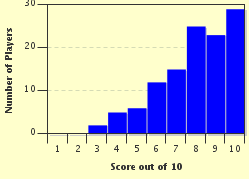Quiz Answer Key and Fun Facts
1. Which small, but tenacious African carnivore has been designated "the world's most fearless animal" by the "Guinness World Records"?
2. Which reclusive long haired member of the hyena family is also known as the "strandwolf" or "beach wolf"?
3. Known for its haunting baby-like cry that carries through the night, what type of animal is a bushbaby?
4. To assist in their nocturnal hunting, owls have special neck adaptations which allow them to rotate their necks about 270 degrees in each direction.
5. Although not totally nocturnal, which animal's nightly feeding behaviour has led to it being responsible for more human deaths in Africa than any other large animal?
6. Which nocturnal, insect eating mammal has a long pig-like snout that has led to it being called an "earth pig" in Afrikaans?
7. Which large, solitary and nocturnal member of the cat family is included in the so-called "Big Five" because of its cunning and strength?
8. It is a myth that the solitary and nocturnal porcupine is capable of shooting or throwing its quills at attackers when threatened.
9. Which small, nocturnal mammal is most commonly associated with both the perfume and the coffee industries?
10. The adage goes that the female of the species is deadlier than the male. In the case of which nocturnal animal, estimated to be responsible for more than one million deaths a year, is this adage true?
Source: Author
KayceeKool
This quiz was reviewed by FunTrivia editor
Tizzabelle before going online.
Any errors found in FunTrivia content are routinely corrected through our feedback system.

